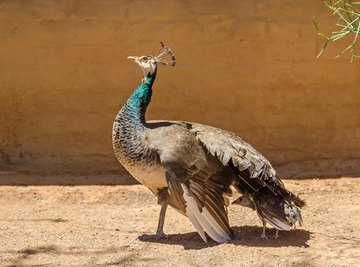
Though the peacock is known for its distinctive, brightly colored tail feathers, that physical feature is possessed only by males of the species; the female peafowl, called a peahen, is far more plain in its plumage. Peachicks, or baby peafowl, share this plainness regardless of sex until they've reached roughly five months of age. As a result, identifying the sex of a peachick requires more than a simple visual inspection. Luckily, methods exist to distinguish the sexes – though some can be time-consuming.
TL;DR (Too Long; Didn't Read)
Peafowl are sexually dimorphic birds, meaning that the two sexes exhibit different physical characteristics: only male peafowl, or peacocks, possess the lustrous blue feathers and bright train of tail feathers the species is known for. Because these physical traits do not develop for a few months, the only way to immediately determine a peachick's sex is through close examination of the cloaca or the testing of the bird's excrement or blood. Given a few weeks, however, the sex of a peachick can generally be determined by observing the bird's leg length, chest color, and behavior in groups.
Sexing for Peacocks
While peafowl are sexually dimorphic birds, meaning that the two sexes display different physical characteristics, these sex-linked traits aren’t expressed until the bird is a few months old. Because feather color is a sex-linked trait in older male peafowl, this means that all peachicks have the same coloration for the first few weeks of their lives: white peacock chicks are visually indistinguishable from white peahen chicks. As a result, identifying and confirming the sex of these birds at a young age – a process known as sexing – is difficult, in the same way as it is for monomorphic birds like cranes. Sexing peacocks and peahens at a young age is possible, but doing so just after birth requires either close physical examination of the inside of a bird’s cloaca, or the testing of a bird’s excrement or blood. These methods requite either a well-trained bird sexer or potentially expensive lab tests, but thankfully, if the peachicks are given a few weeks to grow, observation and less invasive physical examination can be used to identify the sex of the bird.
Peachick Differences
To roughly assess the sex of a peachick between three weeks and two months of age, two primary methods exist. A visual inspection can help determine which chicks will grow into peacocks: though it takes a few months for a young peacock's train of tail feathers to grow, male peachicks tend to have longer legs than their similarly aged female counterparts. They will also have slightly darker feathers on their chests. At the same time, by observing the behavior of peachicks in a group, it is also possible to guess at the sex of a given bird: female peachicks will often stay close to their mother, and will display fewer signs of aggression – though these traits cannot always be relied upon.
References
Tips
- Consider having a blood test down on the chicks. This is the only way to tell fore sure what the sexes of the chicks are in the first year. While you can made educated guesses, it is impossible to know with finality. If you have to know the sex of each of the chicks, such as for business and sale reasons, a blood test is a worthwhile investment.
About the Author
Blake Flournoy is a writer, reporter, and researcher based out of Baltimore, MD. Working independently and alongside professors at Goucher College, they have produced and taught a number of educational programs and workshops for high school and college students in the Baltimore area, finding new ways to connect students to biology, psychology, and statistics. They have never seen Seinfeld and are deathly scared of wasps.
